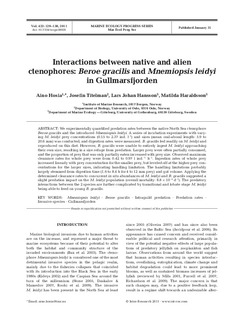| dc.contributor.author | Hosia, Aino | |
| dc.contributor.author | Titelman, Josefin | |
| dc.contributor.author | Hansson, Lars Johan | |
| dc.contributor.author | Haraldsson, Matilda | |
| dc.date.accessioned | 2011-11-24T12:40:27Z | |
| dc.date.issued | 2011-01-31 | |
| dc.identifier.issn | 0171-8630 | |
| dc.identifier.issn | 1616-1599 | |
| dc.identifier.uri | http://hdl.handle.net/11250/108790 | |
| dc.description.abstract | We experimentally quantified predation rates between the native North Sea ctenophore Beroe gracilis and the introduced Mnemiopsis leidyi. A series of incubation experiments with varying M. leidyi prey concentrations (0.15 to 2.37 ind. l–1) and sizes (mean oral-aboral length: 5.9 to 20.6 mm) was conducted, and digestion rates were measured. B. gracilis fed readily on M. leidyi and reproduced on this diet. However, B. gracilis were unable to entirely ingest M. leidyi approaching their own size, resulting in a size refuge from predation. Larger prey were often partially consumed, and the proportion of prey that was only partially eaten increased with prey size. Observed maximum clearance rates for whole prey were from 0.42 to 0.97 l ind.–1 h–1. Ingestion rates of whole prey increased linearly with prey concentration for the smaller prey, but leveled off at the higher prey concentrations for the larger sizes, indicating handling limitation. The handling limitations probably largely stemmed from digestion time (1.6 to 8.4 h for 4 to 12 mm prey) and gut volume. Applying the determined clearance rates to concurrent in situ abundances of M. leidyi and B. gracilis suggested a slight predation impact on the M. leidyi population (overall mortality: 8.8 × 10–4 d–1). The predatory interactions between the 2 species are further complicated by transitional and lobate stage M. leidyi being able to feed on young B. gracilis. | no_NO |
| dc.language.iso | eng | no_NO |
| dc.publisher | Inter-Research | no_NO |
| dc.subject | introduced species | no_NO |
| dc.subject | introduserte arter | no_NO |
| dc.title | Interactions between native and alien ctenophores: Beroe gracilis and Mnemiopsis leidyi in Gullmarsfjorden | no_NO |
| dc.type | Journal article | no_NO |
| dc.type | Peer reviewed | no_NO |
| dc.subject.nsi | VDP::Mathematics and natural science: 400::Zoology and botany: 480::Marine biology: 497 | no_NO |
| dc.subject.nsi | VDP::Agriculture and fishery disciplines: 900::Fisheries science: 920::Aquaculture: 922 | no_NO |
| dc.description.embargo | 2016-01-31 | |
| dc.source.pagenumber | 129-138 | no_NO |
| dc.source.volume | 422 | no_NO |
| dc.source.journal | Marine Ecology Progress Series | no_NO |
| dc.identifier.doi | http://dx.doi.org/10.3354/meps08926 | |
